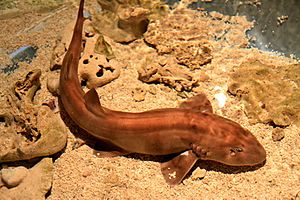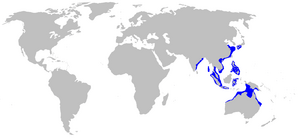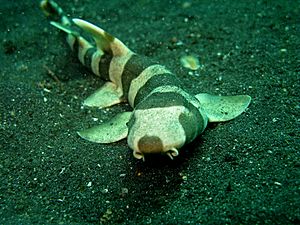Brownbanded bamboo shark facts for kids
Quick facts for kids Brownbanded bamboo shark |
|
|---|---|
 |
|
| Conservation status | |
| Scientific classification | |
| Genus: |
Chiloscyllium
|
| Species: |
punctatum
|
 |
|
| Range of the brownbanded bamboo shark | |
The brownbanded bamboo shark (Chiloscyllium punctatum) is a type of bamboo shark. You can find these sharks in the waters of the Indo-West Pacific ocean, from Japan all the way down to northern Australia. They live in depths up to about 85 meters (279 feet).
These sharks can grow to be about 1.04 meters (41 inches) long. Adult sharks are usually brownish with only faint stripes. However, young sharks are much more colorful! They have clear dark and pale stripes, making them easy to spot.
The brownbanded bamboo shark is listed as "Near Threatened" by the IUCN Red List. This means their population is decreasing, and they could become endangered if we don't protect them. The biggest dangers to these sharks are losing their homes (habitat), pollution, and being caught for the aquarium trade or for food.
These sharks lay eggs to reproduce. They are often raised in public aquaria (large aquariums open to the public). They are one of the best sharks to keep in aquariums because they are calm, don't move around too much, and stay a relatively small size. In public aquariums, these sharks can live for up to 25 years!
Contents
Cool Features of the Brownbanded Bamboo Shark
You can tell these sharks apart by their special dorsal fin (the fin on their back). It has a curved shape at the back. While adult sharks don't have many patterns, young sharks have cool dark stripes and some dark spots.
These sharks are mostly active at night, which means they are nocturnal. They can even survive out of the water for up to 12 hours! Brownbanded bamboo sharks have special sensory organs called barbels. These look like whiskers and help them find food in the dark. Because of these barbels, they are sometimes called "cat sharks." But don't be fooled! They are not true members of the catshark family. They are actually more closely related to nurse sharks, wobbegongs, and even whale sharks.
Where They Live
Brownbanded bamboo sharks love to live around coral reefs. You can also find them in tide pools, which are small pools of water left behind when the tide goes out.
Keeping Brownbanded Bamboo Sharks as Pets
If you're thinking about keeping one of these sharks, an adult brownbanded bamboo shark needs a very large tank, at least 180 gallons. Since they are nocturnal, they need a shaded area in their tank where they can hide during the day.
Even though these sharks don't swim around a lot, it's important that everything inside their tank is very stable. Brownbanded bamboo sharks are quite strong and can knock things over if they're not secure! Also, it's best not to keep them with fish like triggerfish or pufferfish. These fish might nip at the shark's fins. They also shouldn't be with fish that eat very aggressively, as the shark might not get enough food.
What They Eat
Brownbanded bamboo sharks are carnivores, meaning they eat meat. They should be fed about 2-3 times a week. Their diet can include fresh shrimp, scallops, squid, and other marine fish. It's also a good idea to give them iodine supplements. This helps prevent a disease called goiter.
When feeding your shark, remember two things:
- Make sure the food pieces are small enough for them to eat easily. If the pieces are too big, they might spit them back out.
- Sometimes young sharks can be picky eaters. Adding a little extra flavor to their food can make them more interested in eating!
See also
 In Spanish: Chiloscyllium punctatum para niños
In Spanish: Chiloscyllium punctatum para niños



